Ask someone about the big idea that informs their modeling and you’ll either get a blank stare or mumblings about the steam-to-diesel transition era.
We settle for variations on themes like this but they are only window dressing. We seldom consider that our work can embrace a larger question like how to manipulate space, or how color can influence the mood of the viewer and their perception of the model. We ignore bigger ideas like these because we haven’t been taught the concepts or given the tools to explore them thoroughly.
I would love to say that my choice of a big idea was a deliberate one but it wasn’t. I stumbled onto it by accident yet, I’ve been chasing and developing this idea for many years. My larger idea is about space and how we perceive and use it with a railroad model.
Our relationship with space is a strained one at best. Historically, we’ve framed the discussion in adversarial terms that focus on the lack of space rather than ways to better use what we have. The impact of this mental framework influences every decision and our beliefs about the possibilities that are available to us. I suggest our focus is misplaced. By focusing on the negative (I don’t have enough space), all we see is the obstacle. Therefore, driven by this perceived obstacle, we seek out compromise after compromise, in a vain attempt to satisfy a set of largely unrealistic expectations. What if we focused on the space we have and the opportunity it presents as being enough. How would that shift guide our thinking?
Over the past twenty years my layouts have gotten smaller. I’ve gradually narrowed down the width of the benchwork from two feet to sixteen inches and reduced the overall size of each layout, because I realized that I didn’t want or need that much volume. But building small is again, simply window dressing. The larger exercise comes into play with how I’m using the space.
The cameo framework I’m using now is a natural and satisfying fit, especially for quarter-inch scale. The narrow fifteen-inch depth eliminates wasted space and it’s easy to direct the focus where I want it. Beyond those qualities, the two cameos I’ve built couldn’t be more different in the way I’m suggesting the volume of space.
13th And North E
This design is about manipulating open and closed spaces. The two buildings act as solid volumes that define and contrast the open areas of the empty lot and street grid.
The sense here is one of enclosure. You are surrounded by massive brick structures that you cannot see completely without turning your head. What makes this work is the lack of a visible sky. Turn this way or that and all you see are buildings. The lack of a deeper view contributes significantly to the feeling of enclosure. The shape of the fascia and its opening strengthens this interplay of space by framing the view in specific ways. Playing with these spaces can be done quite deliberately and, with a purpose.
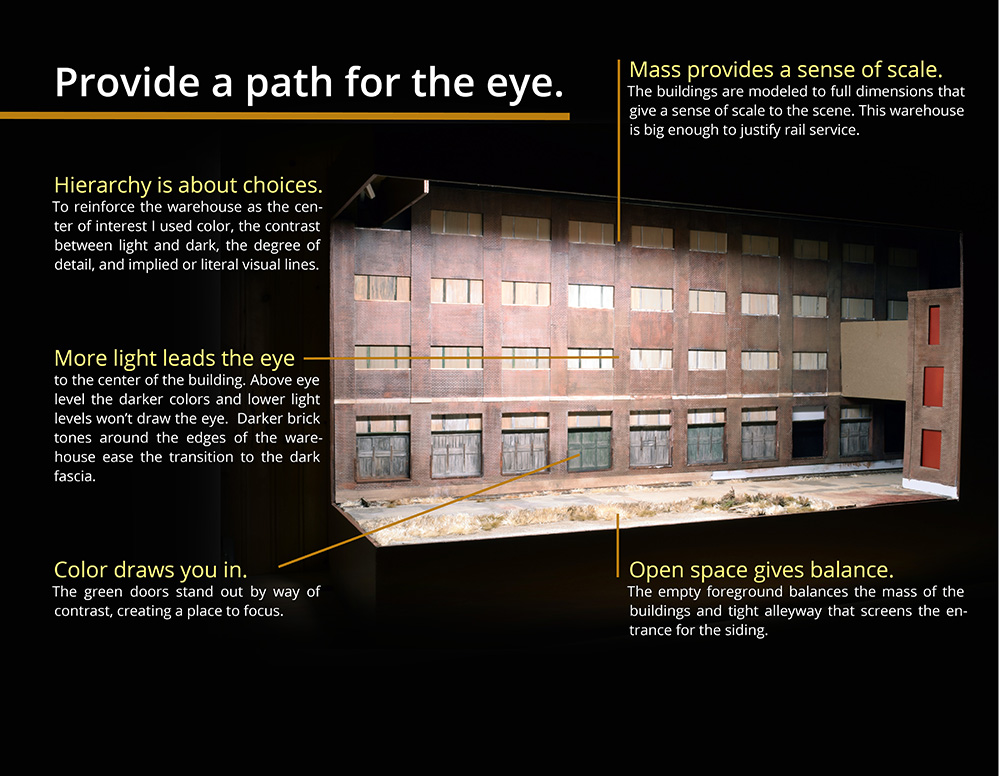
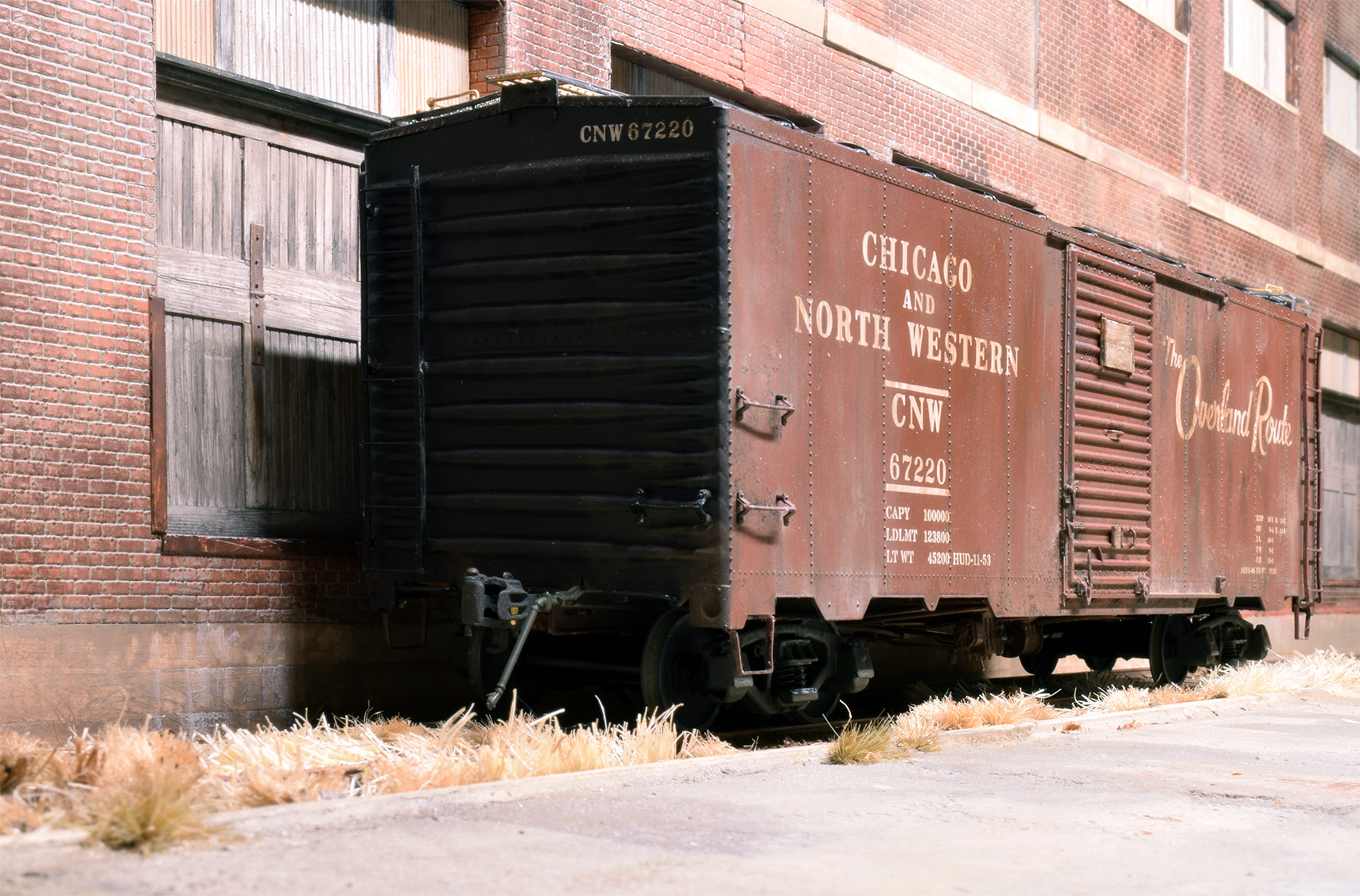
By contrast the current cameo project plays with the idea of open space. Early on I realized how the simple backdrop gives this spacious quality that has influenced my thinking each step of the way as I develop the model. Here the aim is to maintain a feeling of space as I add the additional elements I want in the scene.
As the scenery progresses, the grade crossing has become a natural focal point. The addition of the sycamore tree model I’ve discussed in recent posts will strengthen the area even more. However, there is a fine line to walk with such details, as mistakes in judgment are easy to make. It’s important to look at how each additional detail impacts the whole.
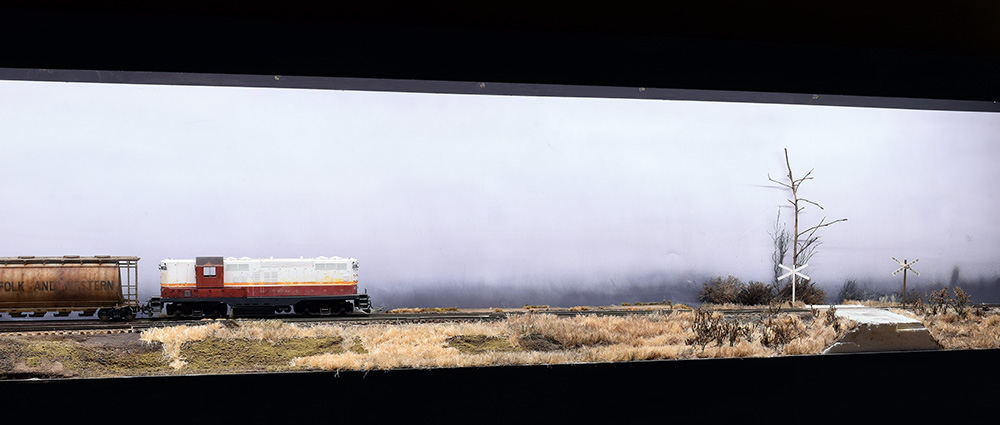
It’s one thing to judge the tree against the surrounding scenery but bringing in a boxcar gives a solid reference point that doesn’t change (below right). Unlike the width of the road or the height of the trees, the scale of the trains is fixed across the entire scene. If the other elements clash with this fixed reference, that’s a problem that needs attention. In studying the mock-up over several days, I believe the overall height is good with room to go a bit higher with the finer branches if I choose. However, as the saying goes: “But wait, there’s more.”
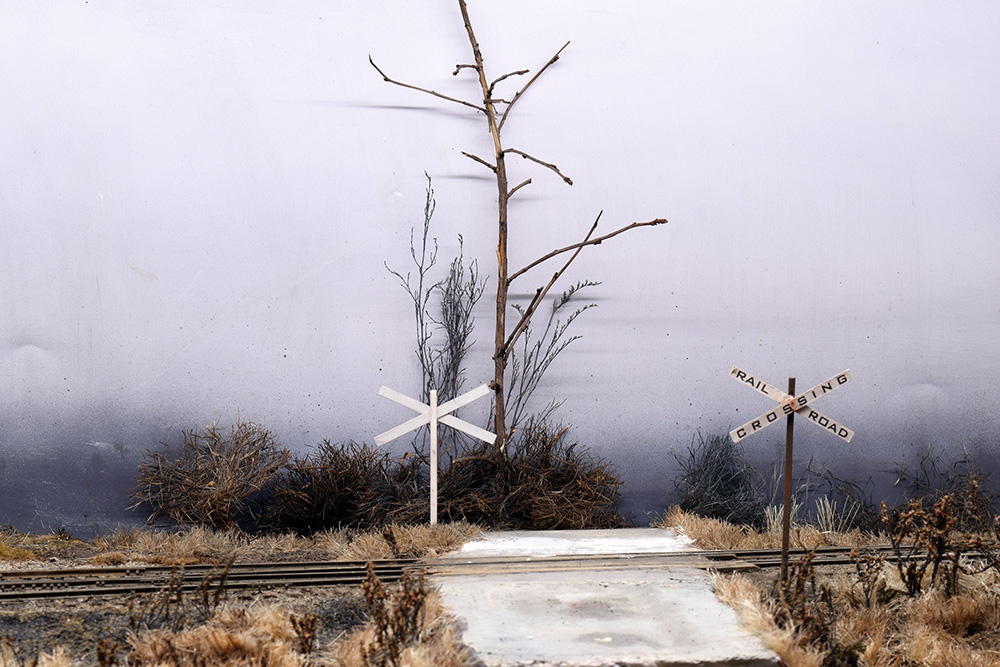
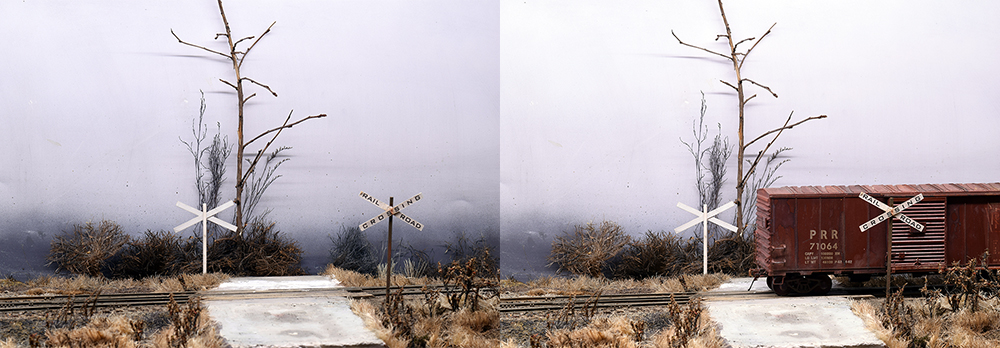
As Matt Lachance pointed out, the low lighting fascia with its long rectangular form emphasizes the horizontal nature of the cameo. The vertical line of this single tree makes a powerful contrast that would be diluted if I added more trees to the scene. Furthermore, a lone tree preserves the open space feel of the cameo. At this point, I intend to exercise restraint with adding more vertical elements and those that I do add will be subordinate to the sycamore by the crossing.
In Closing
While both cameos are largely proto-freelanced scenes, what about prototype modeling? With strict prototype modeling, it’s easy to take a paint-by-number approach because we believe that is required to faithfully replicate a scene. Where does the artistry and aesthetic judgment come into play? One can have a near perfect replica of a real location that is devoid of any soul or atmosphere. While every detail may be in its place the result is less than it could be.
Contrast this with a scene that draws you in like a moth to flame. What creates the difference? I believe the answer lies in the modeler’s intent. If you think of a layout as a game board that lets you pretend you’re a railroad employee for the night, that’s a very different intent from seeing it as a canvas for expressing the artistry of trains and model making.
We are well versed in how to model the literal but poorly equipped otherwise. It doesn’t have to be this way, unless we choose to settle for it. We can capture the intangible with our modeling but only if we believe it’s possible. Everything in this blog and my books is a form of asking and answering the same question: What is your intent?
Regards,
Mike
Okay, Mike. Challenge accepted. Rather than clog your comments with my bloviated ramblings, I posted my answer to your question at my own blog:
https://ocalicreek.blogspot.com/2018/12/whats-intent.html
I hope you don’t mind; I borrowed your title, and I have issued a challenge for other bloggers to do likewise on their own blogs.
This question is THE question. The answer we each give determines so much about our railroads. Our inability to consider the questions sets us up for a short-lived and possibly expensive failure to achieve something that will provide lifelong satisfaction. This hobby has the ability to give us that if we engage with it.
The other question I didn’t address in my blog post but which really resonated deep inside is this one, “What if we focused on the space we have and the opportunity it presents as being enough. How would that shift guide our thinking?” Yep. I made this shift and have been continually driven to make the most of my space and realize a really cool vision in that smaller area. Freed from the what IF, I am free to create in the what IS.
Great point. I could fill my basement with a layout but I won’t. Why? Because after years of pondering the question you’ve raised and seeing friends launch in to lofty projects only to get 5 years in and halfway finished they abandoned the quest for whatever reason I finally decided no, I’m staying small, detailed, and most of all attainable. What happens if others don’t like it or don’t share my vision? I’m not in this to please someone else. I’m here for me and I will willingly share my time and assist you in your visions but I’ve finally put the pieces in the right place for me. The modeler who goes in wondering “what will people think?” or “will this get me recognition or adulation in the hobby or the hobby press?” is doing themselves a disservice. So, my answer – I’m going to enjoy this rich, wonderful hobby and go wherever the flow takes me – even if it is a cameo with one building, one track, one light pole and one tree because I will have a great time building and detailing it.
…because I will have a great time building and detailing it.
And that, in the end, is what this craft is all about folks. We each get to choose the best way to pursue it.
Cheers Jeff and well said.
Mike
Thanks Galen. I appreciate you taking the initiative.
Merry Christmas
Mike
So,the question becomes, “How do I best use this space to portray my inspiration?”
Interesting re-framing.
Simon,
Yes. Instead of obsessing over what you don’t have, make the best out of what you do.
Mike